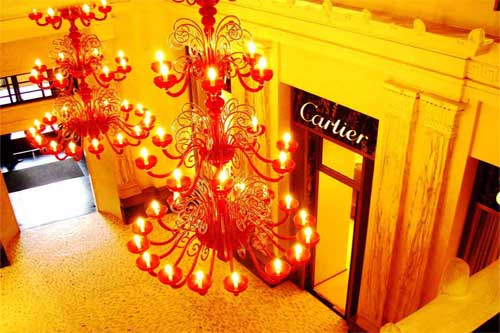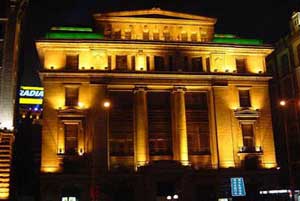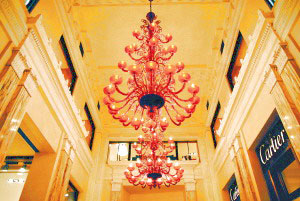The Chartered Bank of India, Australia and China was the oldest of the foreign banks in Shanghai. It was established in 1853 and opened its first branch in Shanghai in 1857. Three earlier banks—the Oriental, the Chartered Mercantile and the Agra were to flounder. The site on which the building stands was purchased from the Oriental Bank in 1893. Lions’heads on sandstone bronze lamp brackets, emblematic of the British nationality of the bank, once adorned each side of the entrance gates. Floral motifs from the surviving English made bronze gates, which despite their Creek detailing had an Oriental feel, were used in the banking hall. Originally, carved keystones, representing India, Australia and China, incorporating rams’heads were set over the ground floor windows.
The entrance vestibule featured four Brecchia marble columns, and the walls were lined with a rich, cream colored, Pavonazzo marble on a black plinth. The original floor was in Roman marble mosaic and the ceiling of fibrous plaster. With the exception of the woodwork, the whole of the wall, floor, coffered ceiling and sculpted Italian marble found on the ground floor was shipped from England. The entire ground floor and the basement were occupied by the bank. The steel framed building, designed by Tug Wilson in a classic neo Greek style with little ornamentation, rested on two reinforced rafts, one for the main block and one for the back block where the treasuries were situated. The contractors, Trollope H Colls, had erected the head office of the bank in London some years earlier. The Shanghai branch was opened in early May 1923 at a ceremony presided over by Sidney Barton, the British Consul.

Last over 80 years later, in 2004, the building reopened to great acclaim as Bund 18. Its Taiwanese developers spent effort in restoring as much as possible of the original architectural vision, besides incorporating harmonious modern additions to satisfy present day needs. The entrance and banking hall now plays host to a range of luxury emporia, including Cartier and Zegna. Zegna’s new headquarters are found on the third floor. The upper floors house the Bund 18 Creative Centre, the Tan Wai Lou Chinese Restaurant, and Sens Sc Bund with its rooftop Bar Rouge. Sens Sc Bund is managed by the Michelin 3 star rated Pourcel brothers and Bar Rouge has evolved as the choicest of night-time destinations.
The restoration was presided over by Pilippo Gabbiani of Kokaistudios. Mr. Gabbiani’s family, themselves distinguished traditional glass makers, bought Marco Polo’s former house in Venice when he was just eight and, from that day on, China was his dream. Filippo fell in love with China on his first visit in 1991. He had his first experience of architectural restoration work at the age of 19. His work on Bund 18, alongside four of his staff, started in 2002 with an intensive three month critical survey of the building. The restoration phase took one year, during which the Chinese staff were trained in restoration techniques that had long been forgotten. Work went on day after day, 24 hours a day, with the project proving to be one of the most challenging Mr. Gabbiani had ever undertaken.
He ensured that no attempt was made to reproduce or imitate the old design features and style if they could not be restored.‘For me it is important that you leave the fingerprint of what you did in a very readable way—so in the future people can be able to recognise what is original and what was added when and how.’His work, and that of his team, was rewarded with Bund 18 winning the Award of Excellence in the 2006 UNESCO Asia Pacific Heritage Awards.

